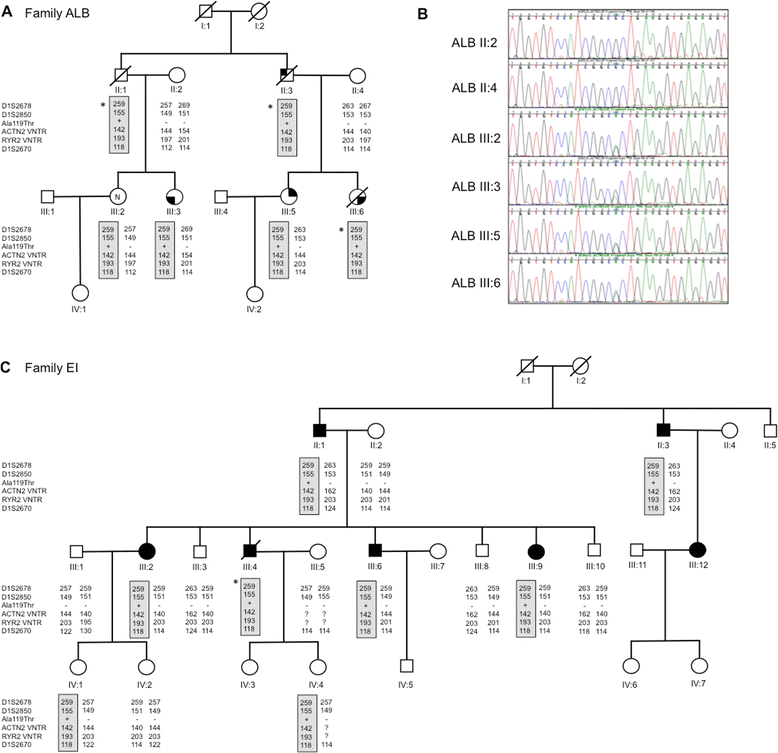Exome sequencing identifies a mutation in the ACTN2 gene in a family with idiopathic ventricular fibrillation, left ventricular noncompaction, and sudden death
- PMID: 25224718
- PMCID: PMC4355500
- DOI: 10.1186/s12881-014-0099-0
Exome sequencing identifies a mutation in the ACTN2 gene in a family with idiopathic ventricular fibrillation, left ventricular noncompaction, and sudden death
Abstract
Background: Potentially lethal and heritable cardiomyopathies and cardiac channelopathies are caused by heterogeneous autosomal dominant mutations in over 50 distinct genes, and multiple genes are responsible for a given disease. Clinical genetic tests are available for several of the inherited cardiac diseases and clinical investigations guide which test to order. This study describes a family with cardiac disease in which marked clinical diversity exists. In the absence of a unified clinical diagnosis, we used exome sequencing to identify a causal mutation.
Methods: Clinical evaluation of family members was performed, including physical examination, electrocardiography, 2D transthoracic echocardiography and review of autopsy records. Exome sequencing was performed on a clinically affected individual and co-segregation studies and haplotype analysis were performed to further confirm pathogenicity.
Results: Clinically affected members showed marked cardiac phenotype heterogeneity. While some individuals were asymptomatic, other presentations included left ventricular non-compaction, a resuscitated cardiac arrest due to idiopathic ventricular fibrillation, dilated cardiomyopathy, and sudden unexplained death. Whole exome sequencing identified an Ala119Thr mutation in the alpha-actinin-2 (ACTN2) gene that segregated with disease. Haplotype analysis showed that this mutation segregated with an identical haplotype in a second, previously described family with clinically diverse cardiac disease, and is likely inherited from a common ancestor.
Conclusions: Mutations in the ACTN2 gene can be responsible for marked cardiac phenotype heterogeneity in families. The diverse mechanistic roles of ACTN2 in the cardiac Z-disc may explain this heterogeneous clinical presentation. Exome sequencing is a useful adjunct to cardiac genetic testing in families with mixed clinical presentations.
Figures





Similar articles
-
Whole-Exome Sequencing Identifies a Novel Mutation (p.L320R) of Alpha-Actinin 2 in a Chinese Family with Dilated Cardiomyopathy and Ventricular Tachycardia.Cytogenet Genome Res. 2019;157(3):148-152. doi: 10.1159/000496077. Epub 2019 Jan 11. Cytogenet Genome Res. 2019. PMID: 30630173
-
Molecular autopsy and clinical family screening in a case of sudden cardiac death reveals ACTN2 mutation related to hypertrophic/dilated cardiomyopathy and a novel LZTR1 variant associated with Noonan syndrome.Mol Genet Genomic Med. 2022 Jul;10(7):e1954. doi: 10.1002/mgg3.1954. Epub 2022 Jun 3. Mol Genet Genomic Med. 2022. PMID: 35656879 Free PMC article.
-
A mutation in CALM1 encoding calmodulin in familial idiopathic ventricular fibrillation in childhood and adolescence.J Am Coll Cardiol. 2014 Jan 28;63(3):259-66. doi: 10.1016/j.jacc.2013.07.091. Epub 2013 Sep 25. J Am Coll Cardiol. 2014. PMID: 24076290
-
Molecular genetic diagnostics for ventricular arrhythmias and sudden cardiac death syndromes.Herz. 2017 Aug;42(5):476-484. doi: 10.1007/s00059-017-4583-0. Herz. 2017. PMID: 28616646 Review. English.
-
Sudden death and cardiac arrest without phenotype: the utility of genetic testing.Trends Cardiovasc Med. 2017 Apr;27(3):207-213. doi: 10.1016/j.tcm.2016.08.010. Epub 2016 Aug 31. Trends Cardiovasc Med. 2017. PMID: 27692676 Review.
Cited by
-
Current Understanding of the Role of Cytoskeletal Cross-Linkers in the Onset and Development of Cardiomyopathies.Int J Mol Sci. 2020 Aug 15;21(16):5865. doi: 10.3390/ijms21165865. Int J Mol Sci. 2020. PMID: 32824180 Free PMC article. Review.
-
Minor hypertrophic cardiomyopathy genes, major insights into the genetics of cardiomyopathies.Nat Rev Cardiol. 2022 Mar;19(3):151-167. doi: 10.1038/s41569-021-00608-2. Epub 2021 Sep 15. Nat Rev Cardiol. 2022. PMID: 34526680 Review.
-
Practical Aspects in Genetic Testing for Cardiomyopathies and Channelopathies.Clin Biochem Rev. 2019 Nov;40(4):187-200. doi: 10.33176/AACB-19-00030. Clin Biochem Rev. 2019. PMID: 31857740 Free PMC article. Review.
-
Mapping the evolving landscape of super-enhancers during cell differentiation.Genome Biol. 2021 Sep 15;22(1):269. doi: 10.1186/s13059-021-02485-x. Genome Biol. 2021. PMID: 34526084 Free PMC article.
-
Left ventricular noncompaction cardiomyopathy: cardiac, neuromuscular, and genetic factors.Nat Rev Cardiol. 2017 Apr;14(4):224-237. doi: 10.1038/nrcardio.2016.207. Epub 2017 Jan 12. Nat Rev Cardiol. 2017. PMID: 28079110 Review.
References
Publication types
MeSH terms
Substances
Supplementary concepts
LinkOut - more resources
Full Text Sources
Other Literature Sources
Medical
Molecular Biology Databases

